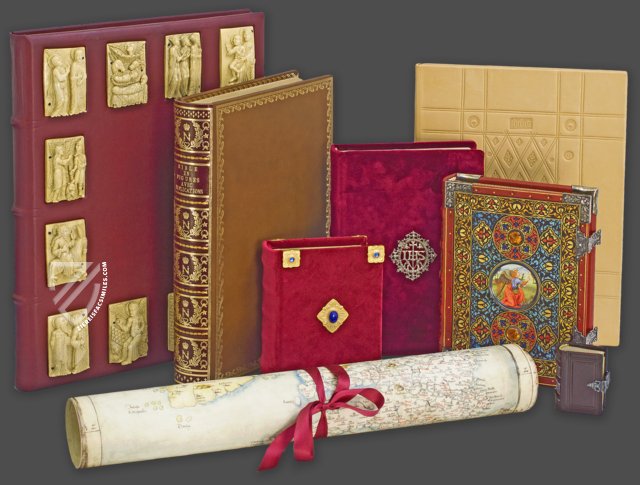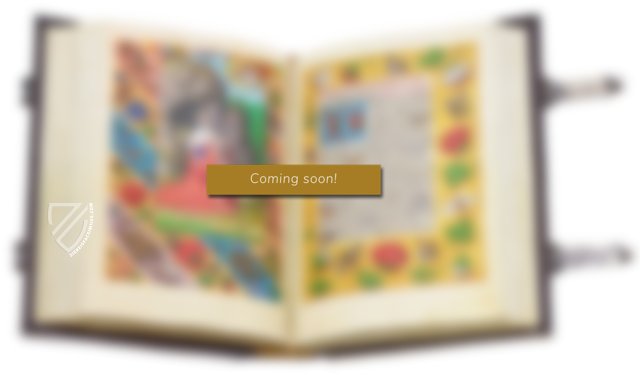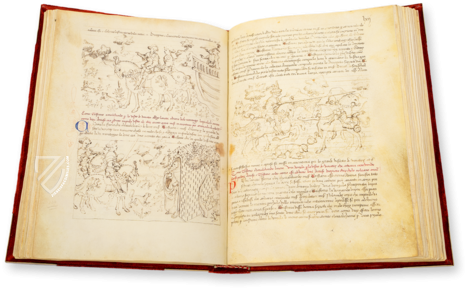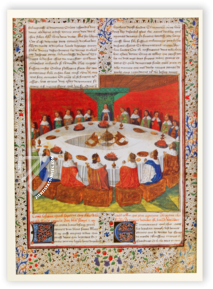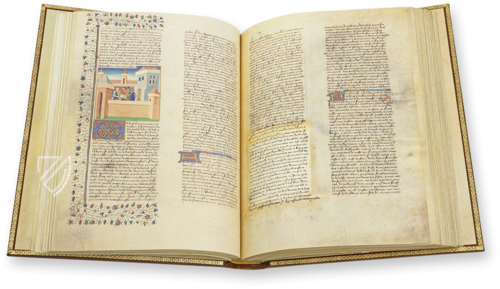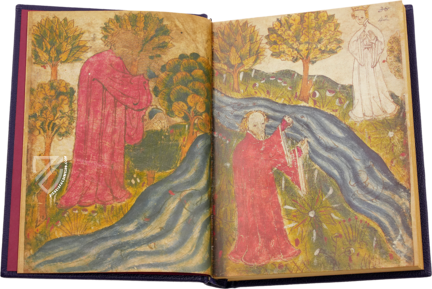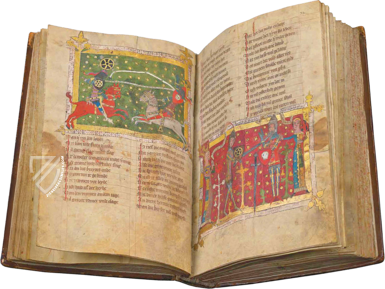Quest for the Holy Grail and Death of King Arthur
(1,000€ - 3,000€)
On July 4, 1470, a precious and extraordinary manuscript was completed in the workshop of the gifted illuminator Évrard d'Espinques for the Count of Nemours, Jacques d'Armagnac (1433–1477): The Quest for the Holy Grail and Death of King Arthur. It contains a monarchy critical compilation of the legendary tales about the search for the mystical cup of the Last Supper and was richly decorated with 133 smaller and larger miniatures, gold decorated borders and beautiful decorated initials. The images not only emphasize the martial facets of the stories, but also give us today a vividly colored glimpse into an idealized world of late medieval chivalry.
A Noble Commission
A great lover of the legends surrounding King Arthur, Jacques d'Armagnac (1433–1477), Duke of Nemours and Count of La Marche and Castres, had four illuminated manuscripts on this subject produced for his library at his residence in Castres in Languedoc. While the first volume was already lost in the 16th century, the other three precious codices survived the ravages of time and are now kept in the Bibliothèque nationale de France. The fourth manuscript, Quest for the Holy Grail and Death of King Arthur, was finished for the Duke on July 4, 1470 and is the most elaborately decorated one. It is an artistic testimony to the patronage of the Duke of Nemours, who was not only a great patron of book illumination, but made history in particular for his rebellion against the French crown, which eventually cost him his head in 1477.
Critique of the Monarchy in a Classic of Medieval Literature
This magnificent manuscript contains an extraordinary compilation of the legendary tales of the quest for the Holy Grail (fol. 1r-182r) and the legend of King Arthur's death (fol. 182r-233r). The Quest is presented in a version in which King Arthur, together with the Knights of the Round Table, goes in search of the mystical vessel with which Jesus celebrated the Last Supper and in which Joseph of Arimathea collected the blood of Christ on the cross. In the late medieval codex, the famous narratives that emerged in the 12th and 13th centuries were adapted to the changing cultural and social context. For example, an episode about the death of King Mark from the Tristan legend (fol. 160r-163r) was included, which is quite unusual in the French tradition. It is also remarkable that a critical attitude towards the centralist monarchy in France is implied on both the textual and pictorial levels.
A Glimpse into the World of Chivalry
The two-column text was written by Micheau Gonnot, a scribe in the Duke's service, in an eminently legible bastarda with a dynamic momentum. The neat script is repeatedly interrupted by a total of 133 differently sized, colorful and mostly gold-decorated miniatures. Many of them extend across both columns taking up nearly half a page. Most of them, however, can be read like small windows into the stories and are only one column wide. Here, tournament and battle scenes, which idealize and romanticize late medieval chivalry, take up a particularly large amount of space, emphasizing the martial aspects of the tales. At the same time, however, the miniatures also provide order and structure and help readers find their way around the codex, which comprises 233 parchment folios. Vegetable borders and ornamental initials with many golden details additionally emphasize important passages in the text, introduce new sections and chapters, and together decorate the clearly structured pages.
Masterly Book Illumination
The pictorial decoration of this beautiful manuscript was done by the workshop of the prolific illuminator Évrard d'Espinques. The latter was actually from northern Germany, but was active in Paris from 1440 and later in the county of La Marche, and was "employed" as an illuminator by Jacques d'Armagnac from 1461. As such, he was responsible for the artful illumination of several manuscripts of courtly literature, some of which still survive today.
In royal possession
After the duke's death, the codex came into the possession of Montjehan family. Later it was in the library of Charles III (1490–1527), Duke of Bourbon. There too, the manuscript did not remain for too long, as it soon passed into the hands of the French King Francis I. (1494–1547). There the manuscript remained until the dissolution of the royal library in 1792, which led to the establishment of the Bibliothèque nationale, where the manuscript still resides today.
Codicology
- Alternative Titles
- Il manoscritto Français 112(3)
Die Suche nach dem Heiligen Gral und der Tod des Königs Artus
La Queste del Saint-Graal, La Mort du roi Artu
Re Artù
I Cavalieri della Tavola Rotonda e la Ricerca del Santo Graal
Compilation arthurienne de Micheau Gonnot
Le denier livre de messire Lancelot du Lac - Size / Format
- 466 pages / 43.0 × 30.0 cm
- Origin
- France
- Date
- July 4, 1470
- Epochs
- Style
- Genre
- Language
- Script
- French littera bastarda
- Illustrations
- 9 large and 121 column-wide miniatures, numerous decorated initials and floral borders
- Content
- A unique compilation of texts that brings together the legends of the quest for the Holy Grail, the death of King Arthur and Tristan
- Patron
- Jacques d'Armagnac
- Artist / School
- Evrard d'Espinques (illuminator)
Micheau Gonnot (scribe) - Previous Owners
- Montjehan family
Charles III, Duke of Bourbon
#1 Il manoscritto Français 112(3)
Language: Italian
(1,000€ - 3,000€)
- Treatises / Secular Books
- Apocalypses / Beatus
- Astronomy / Astrology
- Bestiaries
- Bibles / Gospels
- Chronicles / History / Law
- Geography / Maps
- Saints' Lives
- Islam / Oriental
- Judaism / Hebrew
- Single Leaf Collections
- Leonardo da Vinci
- Literature / Poetry
- Liturgical Manuscripts
- Medicine / Botany / Alchemy
- Music
- Mythology / Prophecies
- Psalters
- Other Religious Books
- Games / Hunting
- Private Devotion Books
- Other Genres
- Afghanistan
- Armenia
- Austria
- Belgium
- Belize
- Bosnia and Herzegovina
- China
- Colombia
- Costa Rica
- Croatia
- Cyprus
- Czech Republic
- Denmark
- Egypt
- El Salvador
- Ethiopia
- France
- Germany
- Greece
- Guatemala
- Honduras
- Hungary
- India
- Iran
- Iraq
- Israel
- Italy
- Japan
- Jordan
- Kazakhstan
- Kyrgyzstan
- Lebanon
- Liechtenstein
- Luxembourg
- Mexico
- Morocco
- Netherlands
- Palestine
- Panama
- Peru
- Poland
- Portugal
- Romania
- Russia
- Serbia
- Spain
- Sri Lanka
- Sweden
- Switzerland
- Syria
- Tajikistan
- Turkey
- Turkmenistan
- Ukraine
- United Kingdom
- United States
- Uzbekistan
- Vatican City
- A. Oosthoek, van Holkema & Warendorf
- Aboca Museum
- Ajuntament de Valencia
- Akademie Verlag
- Akademische Druck- u. Verlagsanstalt (ADEVA)
- Aldo Ausilio Editore - Bottega d’Erasmo
- Alecto Historical Editions
- Alkuin Verlag
- Almqvist & Wiksell
- Amilcare Pizzi
- Andreas & Andreas Verlagsbuchhandlung
- Archa 90
- Archiv Verlag
- Archivi Edizioni
- Arnold Verlag
- ARS
- Ars Magna
- ArtCodex
- AyN Ediciones
- Azimuth Editions
- Badenia Verlag
- Bärenreiter-Verlag
- Belser Verlag
- Belser Verlag / WK Wertkontor
- Benziger Verlag
- Bernardinum Wydawnictwo
- BiblioGemma
- Biblioteca Apostolica Vaticana (Vaticanstadt, Vaticanstadt)
- Bibliotheca Palatina Faksimile Verlag
- Bibliotheca Rara
- Boydell & Brewer
- Bramante Edizioni
- Bredius Genootschap
- Brepols Publishers
- British Library
- C. Weckesser
- Caixa Catalunya
- Canesi
- CAPSA, Ars Scriptoria
- Caratzas Brothers, Publishers
- Carus Verlag
- Casamassima Libri
- Centrum Cartographie Verlag GmbH
- Chavane Verlag
- Christian Brandstätter Verlag
- Circulo Cientifico
- Club Bibliófilo Versol
- Club du Livre
- CM Editores
- Collegium Graphicum
- Collezione Apocrifa Da Vinci
- Comissão Nacional para as Comemorações dos Descobrimentos Portugueses
- Coron Verlag
- Corvina
- CTHS
- D. S. Brewer
- Damon
- De Agostini/UTET
- De Nederlandsche Boekhandel
- De Schutter
- Deuschle & Stemmle
- Deutscher Verlag für Kunstwissenschaft
- DIAMM
- Droz
- E. Schreiber Graphische Kunstanstalten
- Ediciones Boreal
- Ediciones Grial
- Ediclube
- Edições Inapa
- Edilan
- Editalia
- Edition Deuschle
- Edition Georg Popp
- Edition Leipzig
- Edition Libri Illustri
- Editiones Reales Sitios S. L.
- Éditions de l'Oiseau Lyre
- Editions Medicina Rara
- Editorial Casariego
- Editorial Mintzoa
- Editrice Antenore
- Editrice Velar
- Edizioni Edison
- Egeria, S.L.
- Eikon Editores
- Electa
- Emery Walker Limited
- Enciclopèdia Catalana
- Eos-Verlag
- Ephesus Publishing
- Ernst Battenberg
- Eugrammia Press
- Extraordinary Editions
- Fackelverlag
- Facsimila Art & Edition
- Facsimile Editions Ltd.
- Facsimilia Art & Edition Ebert KG
- Faksimile Verlag
- Feuermann Verlag
- Folger Shakespeare Library
- Franco Cosimo Panini Editore
- Friedrich Wittig Verlag
- Fundación Hullera Vasco-Leonesa
- G. Braziller
- Gabriele Mazzotta Editore
- Gebr. Mann Verlag
- Gesellschaft für graphische Industrie
- Getty Research Institute
- Giovanni Domenico de Rossi
- Giunti Editore
- Graffiti
- Grafica European Center of Fine Arts
- Guido Pressler
- Guillermo Blazquez
- Gustav Kiepenheuer
- H. N. Abrams
- Harrassowitz
- Harvard University Press
- Helikon
- Hendrickson Publishers
- Henning Oppermann
- Herder Verlag
- Hes & De Graaf Publishers
- Hoepli
- Holbein-Verlag
- Houghton Library
- Hugo Schmidt Verlag
- Idion Verlag
- Il Bulino, edizioni d'arte
- ILte
- Imago
- Insel Verlag
- Insel-Verlag Anton Kippenberger
- Instituto de Estudios Altoaragoneses
- Instituto Nacional de Antropología e Historia
- Introligatornia Budnik Jerzy
- Istituto dell'Enciclopedia Italiana - Treccani
- Istituto Ellenico di Studi Bizantini e Postbizantini
- Istituto Geografico De Agostini
- Istituto Poligrafico e Zecca dello Stato
- Italarte Art Establishments
- Jan Thorbecke Verlag
- Johnson Reprint Corporation
- Josef Stocker
- Josef Stocker-Schmid
- Jugoslavija
- Karl W. Hiersemann
- Kasper Straube
- Kaydeda Ediciones
- Kindler Verlag / Coron Verlag
- Kodansha International Ltd.
- Konrad Kölbl Verlag
- Kurt Wolff Verlag
- La Liberia dello Stato
- La Linea Editrice
- La Meta Editore
- Lambert Schneider
- Landeskreditbank Baden-Württemberg
- Leo S. Olschki
- Les Incunables
- Liber Artis
- Library of Congress
- Libreria Musicale Italiana
- Lichtdruck
- Lito Immagine Editore
- Lumen Artis
- Lund Humphries
- M. Moleiro Editor
- Maison des Sciences de l'homme et de la société de Poitiers
- Manuscriptum
- Martinus Nijhoff
- Maruzen-Yushodo Co. Ltd.
- MASA
- Massada Publishers
- McGraw-Hill
- Metropolitan Museum of Art
- Militos
- Millennium Liber
- Müller & Schindler
- Nahar - Stavit
- Nahar and Steimatzky
- National Library of Wales
- Neri Pozza
- Nova Charta
- Oceanum Verlag
- Odeon
- Orbis Mediaevalis
- Orbis Pictus
- Österreichische Staatsdruckerei
- Oxford University Press
- Pageant Books
- Parzellers Buchverlag
- Patrimonio Ediciones
- Pattloch Verlag
- PIAF
- Pieper Verlag
- Plon-Nourrit et cie
- Poligrafiche Bolis
- Presses Universitaires de Strasbourg
- Prestel Verlag
- Princeton University Press
- Prisma Verlag
- Priuli & Verlucca, editori
- Pro Sport Verlag
- Propyläen Verlag
- Pytheas Books
- Quaternio Verlag Luzern
- Reales Sitios
- Recht-Verlag
- Reichert Verlag
- Reichsdruckerei
- Reprint Verlag
- Riehn & Reusch
- Roberto Vattori Editore
- Rosenkilde and Bagger
- Roxburghe Club
- Salerno Editrice
- Saltellus Press
- Sandoz
- Sarajevo Svjetlost
- Schöck ArtPrint Kft.
- Schulsinger Brothers
- Scolar Press
- Scrinium
- Scripta Maneant
- Scriptorium
- Shazar
- Siloé, arte y bibliofilia
- SISMEL - Edizioni del Galluzzo
- Sociedad Mexicana de Antropología
- Société des Bibliophiles & Iconophiles de Belgique
- Soncin Publishing
- Sorli Ediciones
- Stainer and Bell
- Studer
- Styria Verlag
- Sumptibus Pragopress
- Szegedi Tudomànyegyetem
- Taberna Libraria
- Tarshish Books
- Taschen
- Tempus Libri
- Testimonio Compañía Editorial
- Thames and Hudson
- The Clear Vue Publishing Partnership Limited
- The Facsimile Codex
- The Folio Society
- The Marquess of Normanby
- The Richard III and Yorkist History Trust
- Tip.Le.Co
- TouchArt
- TREC Publishing House
- TRI Publishing Co.
- Trident Editore
- Tuliba Collection
- Typis Regiae Officinae Polygraphicae
- Union Verlag Berlin
- Universidad de Granada
- University of California Press
- University of Chicago Press
- Urs Graf
- Vallecchi
- Van Wijnen
- VCH, Acta Humaniora
- VDI Verlag
- VEB Deutscher Verlag für Musik
- Verlag Anton Pustet / Andreas Verlag
- Verlag Bibliophile Drucke Josef Stocker
- Verlag der Münchner Drucke
- Verlag für Regionalgeschichte
- Verlag Styria
- Vicent Garcia Editores
- W. Turnowski Ltd.
- W. Turnowsky
- Waanders Printers
- Wiener Mechitharisten-Congregation (Wien, Österreich)
- Wissenschaftliche Buchgesellschaft
- Wissenschaftliche Verlagsgesellschaft
- Wydawnictwo Dolnoslaskie
- Xuntanza Editorial
- Zakład Narodowy
- Zollikofer AG

